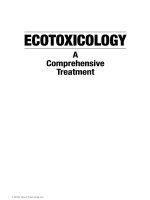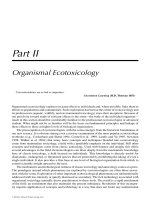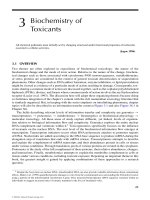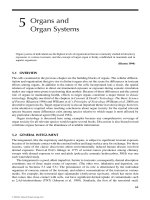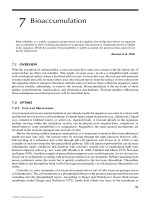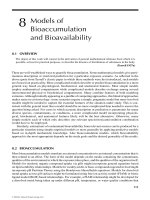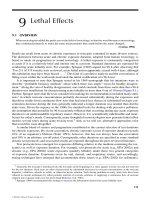ECOTOXICOLOGY: A Comprehensive Treatment - Chapter 1 pptx
Bạn đang xem bản rút gọn của tài liệu. Xem và tải ngay bản đầy đủ của tài liệu tại đây (1.03 MB, 32 trang )
Clements: “3357_c000” — 2007/11/9 — 12:43 — pagei—#1
© 2008 by Taylor & Francis Group, LLC
ECOTOXICOLOGY
A
Comprehensive
Treatment
© 2008 by Taylor & Francis Group, LLC
Clements: “3357_c000” — 2007/11/9 — 12:43 — page iii — #3
ECOTOXICOLOGY
A
Comprehensive
Treatment
Michael C. Newman
William
H.
Clements
CRC Press
Taylor & Francis Group
Boca Raton London New York
CRC Press
is
an imprint
of
the
Taylor Si Francis Group,
an
informa business
© 2008 by Taylor & Francis Group, LLC
Clements: “3357_c000” — 2007/11/9 — 12:43 — page iv — #4
CRC
Press
Taylor
&
Francis Group
6000 Broken Sound Parkway
NW,
Suite 300
Boca
Raton,
FL
33487-2742
©
2008
by
Taylor
&
Francis Group, LLC
CRC
Press
is
an imprint of Taylor
&
Francis Group, an Informa business
No claim to original
U.S.
Government works
Printed in the United States of America on acid-free paper
10987654321
International Standard Book Number-13:978-0-8493-3357-6 (Hardcover)
This book contains information obtained from authentic and highly regarded sources. Reprinted material is quoted
with permission, and sources are indicated.
A wide
variety of references are listed. Reasonable efforts have been made to
publish reliable data and information, but the author and the publisher cannot assume responsibility for the validity of
all materials or for the consequences of their use.
No part of this book
may be
reprinted, reproduced, transmitted, or utilized in any
form
by any
electronic,
mechanical, or
other
means,
now known or hereafter invented, including photocopying, microfilming, and
recording,
or in any informa-
tion storage or retrieval system, without written permission from the publishers.
For permission to photocopy or use material electronically from this work, please access www.copyright.com (http://
www.copyright.com/) or contact the Copyright Clearance Center, Inc. (CCC) 222 Rosewood
Drive,
Danvers, MA
01923,
978-750-8400.
CCC is a
not-for-profit organization that provides licenses and registration for a variety of
users.
For orga-
nizations that have been granted
a
photocopy license
by
the
CCC,
a separate system of payment has been arranged.
Trademark Notice: Product or corporate names may be trademarks or registered trademarks, and are used only for
identification and explanation without intent
to
infringe.
Library of Congress Cataloging-in-Publication Data
Newman, Michael C.
Ecotoxicology: a comprehensive treatment / Michael
C.
Newman and William
H.
Clements,
p.;
cm.
"A CRC
title."
Includes bibliographical references and index.
ISBN
978-0-8493-3357-6 (alk. paper)
1.
Toxicology—Environmental
aspects.
I.
Clements, William
H.
(William
Henry),
1954-
II.
Title.
[DNLM: 1. Environmental Exposure—adverse effects.
2.
Environmental Pollutants—toxicity. 3.
Ecosystem.
4.
Population
Dynamics.
WA 671
E196 2008]
RA1226.N48 2008
615.9'02-dc22 2007017797
Visit the Taylor
& Francis Web
site at
and the
CRC Press Web
site at
© 2008 by Taylor & Francis Group, LLC
Clements: “3357_c000” — 2007/11/9 — 12:43 — pagev—#5
Dedication
To Peg, Ben, and Ian (MCN)
To Diana for her endless support over the years (WHC)
© 2008 by Taylor & Francis Group, LLC
Clements: “3357_c000” — 2007/11/9 — 12:43 — page vii — #7
Do that which will render thee worthy of happiness
Critique of Pure Reason, I. Kant 1781
© 2008 by Taylor & Francis Group, LLC
Clements: “3357_c000” — 2007/11/9 — 12:43 — page ix — #9
Contents
Preface xxv
Authors xxvii
I Hierarchical Ecotoxicology 1
Chapter 1 The Hierarchical Science of Ecotoxicology 3
1.1 An Overarching Context of Hierarchical Ecotoxicology 3
1.1.1 General 3
1.1.2 The Modified Janus Context 4
1.2 Reductionism versus Holism Debate 6
1.2.1 Reductionism versus Holism as a False Dichotomy 6
1.2.2 Microexplanation, Holism, and Macroexplanation 6
1.2.3 A Closer Look at Macroexplanation 7
1.3 Requirements in the Science of Ecotoxicology 8
1.3.1 General 8
1.3.2 Strongest Possible Inference 8
1.4 Summary 9
1.4.1 Summary of Foundation Concepts and Paradigms 9
References 10
II Organismal Ecotoxicology
11
Chapter 2 The Organismal Ecotoxicology Context 13
2.1 Overview 13
2.2 Organismal Ecotoxicology Defined 14
2.2.1 What Is Organismal Ecotoxicology? 14
2.3 The Value of Organismal Ecotoxicology Vantage 18
2.3.1 Tractability and Discreteness 18
2.3.2 Inferring Effects to or Exposure of Organisms with
Suborganismal Metrics 18
2.3.3 Extrapolating among Individuals: Species, Size, Sex, and
Other Key Qualities 19
2.3.4 Inferring Population Effects from Organismal Effects 19
2.3.5 Inferring Community Effects from Organismal Effects 20
2.3.6 Inferring Potential for Trophic Transfer from Bioaccumulation 21
2.4 Summary 21
References 21
Chapter 3 Biochemistry of Toxicants 23
3.1 Overview 23
3.2 DNA Modification 25
© 2008 by Taylor & Francis Group, LLC
Clements: “3357_c000” — 2007/11/9 — 12:43 — pagex—#10
3.3 Detoxification of Organic Compounds 25
3.3.1 Phase I Reactions 26
3.3.2 Phase II (Conjugative) Reactions 27
3.4 Metal Detoxification, Regulation, and Sequestration 28
3.5 Stress Proteins and Proteotoxicity 30
3.6 Oxidative Stress 31
3.7 Enzyme Dysfunction 32
3.8 Heme Biosynthesis Inhibition 32
3.9 Oxidative Phosphorylation Inhibition 35
3.10 Narcosis 35
3.11 Summary 36
3.11.1 Summary of Foundation Concepts and Paradigms 36
References 37
Chapter 4 Cells and Tissues 43
4.1 Overview 43
4.2 Cytotoxicity 43
4.2.1 Necrosis and Apoptosis 43
4.2.2 Types of Necrosis 44
4.2.3 Inflammation and Other Responses 47
4.3 Genotoxicity 50
4.3.1 Somatic and Genetic Risk 50
4.3.2 DNA Damage 52
4.3.3 Chromatids and Chromosomes 52
4.4 Cancer 53
4.4.1 Carcinogenesis 53
4.4.2 Cancer Latency 54
4.4.3 Threshold and Nonthreshold Models 55
4.5 Sequestration and Accumulation 55
4.5.1 Toxicants or Products of Toxicants 55
4.5.2 Cellular Materials as Evidence of Toxicant Damage 56
4.6 Summary 57
4.6.1 Summary of Foundation Concepts and Paradigms 57
References 57
Chapter 5 Organs and Organ Systems 63
5.1 Overview 63
5.2 General Integument 63
5.3 Organs Associated with Gas Exchange 65
5.3.1 Air Breathing 65
5.3.2 Water Breathing 66
5.4 Circulatory System 66
5.5 Digestive System 67
5.6 Liver and Analogous Organs of Invertebrates 68
5.7 Excretory Organs 69
5.8 Immune System 69
5.9 Endocrine System 70
5.10 Nervous, Sensory, and Motor-Related Organs and Systems 72
5.11 Summary 72
5.11.1 Summary of Foundation Concepts and Paradigms 72
References 73
© 2008 by Taylor & Francis Group, LLC
Clements: “3357_c000” — 2007/11/9 — 12:43 — page xi — #11
Chapter 6 Physiology 81
6.1 Overview 81
6.2 Ionic and Osmotic Regulation 82
6.3 Acid–Base Regulation 83
6.4 Respiration and General Metabolism 84
6.5 Bioenergetics 87
6.6 Plant-Related Processes 89
6.7 Summary 90
6.7.1 Summary of Foundation Concepts and Paradigms 90
References 91
Chapter 7 Bioaccumulation 95
7.1 Overview 95
7.2 Uptake 95
7.2.1 Cellular Mechanisms 95
7.2.2 Routes of Entry into Organisms 99
7.2.3 Factors Modifying Uptake 101
7.3 Biotransformation 104
7.4 Elimination 105
7.4.1 Hepatobiliary 106
7.4.2 Renal 106
7.4.3 Branchial 106
7.4.4 Other Elimination Mechanisms 107
7.5 Summary 107
7.5.1 Summary of Foundation Concepts and Paradigms 107
References 108
Chapter 8 Models of Bioaccumulation and Bioavailability 115
8.1 Overview 115
8.2 Bioaccumulation 115
8.2.1 Underlying Mechanisms 116
8.2.2 Assumptions of Models and Methods of Fitting Data 116
8.2.3 Rate Constant-Based Models 118
8.2.4 Clearance Volume-Based Models 122
8.2.5 Fugacity-Based Models 123
8.2.6 Physiologically Based Pharmacokinetic Models 125
8.2.7 Statistical Moments Formulations 125
8.3 Bioavailability 127
8.3.1 Conceptual Foundation: Concentration→Exposure→Realized Dose
→Effect 127
8.3.2 Types and Estimation of Bioavailability 128
8.4 Summary 131
8.4.1 Summary of Foundation Concepts and Paradigms 131
References 132
Chapter 9 Lethal Effects 135
9.1 Overview 135
9.1.1 Distinct Dynamics Arising from Underlaying Mechanisms and
Modes of Action 136
9.1.2 Lethality Differences among Individuals 140
9.1.2.1 Individual Effective Dose Hypothesis 141
9.1.2.2 Probabilistic Hypothesis 142
© 2008 by Taylor & Francis Group, LLC
Clements: “3357_c000” — 2007/11/9 — 12:43 — page xii — #12
9.1.3 Spontaneous and Threshold Responses 144
9.1.4 Hormesis 144
9.1.5 Toxicant Interactions 145
9.2 Quantifying Lethality 146
9.2.1 General 146
9.2.2 Dose or Concentration–Response Models Quantifying Lethality 146
9.2.3 Time–Response Models Quantifying Lethality 150
9.3 Lethality Prediction 154
9.3.1 Organic Compounds and the QSAR Approach 154
9.3.2 Metals and the QICAR Approach 156
9.4 Summary 157
9.4.1 Summary of Foundation Concepts and Paradigms 157
References 158
Chapter10 Sublethal Effects 163
10.1 Overview 163
10.2 General Categories of Effects 166
10.2.1 Development and Growth 166
10.2.2 Reproduction 167
10.2.3 Behavior 167
10.2.4 Physiology 168
10.3 Quantifying Sublethal Effects 168
10.3.1 Hypothesis Testing and Point Estimation 169
10.3.1.1 Basic Concepts and Assumptions of Hypothesis Tests 175
10.3.1.2 Basic Concepts and Assumptions of Point Estimation Methods 179
10.4 Summary 179
10.4.1 Summary of Foundation Concepts and Paradigms 180
References 180
Chapter11 Conclusion 189
11.1 General 189
11.2 Some Particularly Key Concepts 189
11.3 Concluding Remarks 191
III Population Ecotoxicology 193
Chapter12 The Population Ecotoxicology Context 195
12.1 Population Ecotoxicology Defined 195
12.1.1 What Is a Population? 195
12.1.2 Definition of Population Ecotoxicology 196
12.2 The Need for Population Ecotoxicology 196
12.2.1 General 196
12.2.2 Scientific Merit 197
12.2.3 Practical Merit 199
12.3 Inferences within and between Biological Levels 203
12.3.1 Inferring Population Effects from Qualities of Individuals 204
12.3.2 Inferring Individual Effects from Qualities of Populations 204
12.3.3 Inferring Community Effects from Qualities of Populations 205
12.4 Summary 208
12.4.1 Summary of Foundation Concepts and Paradigms 208
References 208
© 2008 by Taylor & Francis Group, LLC
Clements: “3357_c000” — 2007/11/9 — 12:43 — page xiii — #13
Chapter13 Epidemiology: The Study of Disease in Populations 215
13.1 Foundation Concepts and Metrics in Epidemiology 215
13.1.1 Foundation Concepts 215
13.1.2 Foundation Metrics 218
13.1.3 Foundation Models Describing Disease in Populations 224
13.1.3.1 Accelerated Failure Time and Proportional Hazard Models 224
13.1.3.2 Binary Logistic Regression Model 227
13.2 Disease Association and Causation 228
13.2.1 Hill’s Nine Aspects of Disease Association 228
13.2.2 Strength of Evidence Hierarchy 232
13.3 Infectious Disease and Toxicant-Exposed Populations 235
13.4 Differences in Sensitivity within and among Populations 236
13.5 Summary 237
13.5.1 Summary of Foundation Concepts and Paradigms 237
References 238
Chapter14 Toxicants and Simple Population Models 241
14.1 Toxicants Effects on Population Size and Dynamics 241
14.1.1 The Population-Based Paradigm for Ecological Risk 241
14.1.2 Evidence of the Need for the Population-Based Paradigm for Risk 242
14.2 Fundamentals of Population Dynamics 243
14.2.1 General 243
14.2.2 Projection Based on Phenomenological Models: Continuous Growth 244
14.2.3 Projection Based on Phenomenological Models: Discrete Growth 246
14.2.4 Sustainable Harvest and Time to Recovery 247
14.3 Population Stability 250
14.4 Spatial Distributions of Individuals in Populations 253
14.4.1 Describing Distributions: Clumped, Random, and Uniform 253
14.4.2 Metapopulations 254
14.4.2.1 Metapopulation Dynamics 254
14.4.2.2 Consequences to Exposed Populations 256
14.5 Summary 258
14.5.1 Summary of Foundation Concepts and Paradigms 258
References 259
Chapter15 Toxicants and Population Demographics 263
15.1 Demography: Adding Individual Heterogeneity to Population Models 263
15.1.1 Structured Populations 263
15.1.2 Basic Life Tables 264
15.1.2.1 Survival Schedules 264
15.1.2.2 Mortality–Natality Tables 266
15.2 Matrix Forms of Demographic Models 270
15.2.1 Basics of Matrix Calculations 270
15.2.2 The Leslie Age-Structured Matrix Approach 272
15.2.3 The Lefkovitch Stage-Structured Matrix Approach 274
15.2.4 Stochastic Models 276
15.3 Summary 277
15.3.1 Summary of Foundation Concepts and Paradigms 277
References 278
© 2008 by Taylor & Francis Group, LLC
Clements: “3357_c000” — 2007/11/9 — 12:43 — page xiv — #14
Chapter16 Phenogenetics of Exposed Populations 281
16.1 Overview 281
16.1.1 The Phenotype Vantage 281
16.1.2 An Extreme Case Example 281
16.2 Toxicants and the Principle of Allocation (Concept of Strategy) 284
16.2.1 Phenotypic Plasticity and Norms of Reaction 286
16.2.2 Toxicants and Aging 289
16.2.2.1 Stress-Based Theories of Aging 290
16.2.2.2 Disposable Soma and Related Theories of Aging 290
16.2.3 Optimizing Fitness: Balancing Somatic Growth, Longevity,
and Reproduction 291
16.3 Developmental Stability in Populations 294
16.4 Summary 297
16.4.1 Summary of Foundation Concepts and Paradigms 299
References 300
Chapter17 Population Genetics: Damage and Stochastic Dynamics of the Germ Line 305
17.1 Overview 305
17.2 Direct Damage to the Germ Line 306
17.2.1 Genotoxicity 306
17.2.2 Repair of Genotoxic Damage 307
17.2.3 Mutation Rates and Accumulation 309
17.3 Indirect Change to the Germ Line 311
17.3.1 Stochastic Processes 311
17.3.2 Hardy–Weinberg Expectations 313
17.3.3 Genetic Drift 314
17.3.3.1 Effective Population Size 314
17.3.3.2 Genetic Bottlenecks 316
17.3.3.3 Balancing Drift and Mutation 317
17.3.4 Population Structure 317
17.3.4.1 The Wahlund Effect 317
17.3.4.2 Isolated and Semi-Isolated Subpopulations 320
17.3.5 Multiple Locus Heterozygosity and Individual Fitness 324
17.4 Genetic Diversity and Evolutionary Potential 326
17.5 Summary 326
17.5.1 Summary of Foundation Concepts and Paradigms 326
References 327
Chapter18 Population Genetics: Natural Selection 331
18.1 Overview of Natural Selection 331
18.1.1 General 331
18.1.2 Viability Selection 334
18.1.3 Selection Components Associated with Reproduction 337
18.2 Estimating Differential Fitness and Natural Selection 340
18.2.1 Fitness, Relative Fitness, and Selection Coefficients 340
18.2.2 Heritability 343
18.3 Ecotoxicology’s Tradition of Tolerance 345
18.4 Summary 347
18.4.1 Summary of Foundation Concepts and Paradigms 347
References 348
© 2008 by Taylor & Francis Group, LLC
Clements: “3357_c000” — 2007/11/9 — 12:43 — page xv — #15
Chapter19 Conclusion 353
19.1 Overview 353
19.2 Some Particularly Key Concepts 353
19.2.1 Epidemiology 353
19.2.2 Simple Models of Population Dynamics 354
19.2.3 Metapopulation Dynamics 354
19.2.4 The Demographic Approach 354
19.2.5 Phenogenetics Theory 355
19.2.6 Population Genetics: Stochastic Processes 355
19.2.7 Population Genetics: Natural Selection 356
19.3 Concluding Remarks 356
References 356
IV Community Ecotoxicology 359
Chapter20 Introduction to Community Ecotoxicology 361
20.1 Definitions—Community Ecology and Ecotoxicology 361
20.1.1 Community Ecology 361
20.1.2 Community Ecotoxicology 362
20.2 Historical Perspective of Community Ecology and Ecotoxicology 362
20.2.1 Holism and Reductionism in Community Ecology and Ecotoxicology 363
20.2.2 Trophic Interactions in Community Ecology and Ecotoxicology 366
20.2.3 Importance of Experiments in Community Ecology and Ecotoxicology 366
20.3 Are Communities More Than the Sum of Individual Populations? 367
20.3.1 The Need to Understand Indirect Effects of Contaminants 367
20.4 Communities within the Hierarchy of Biological Organization 370
20.5 Contemporary Topics in Community Ecotoxicology 372
20.5.1 The Need for an Improved Understanding of Basic Community Ecology 372
20.5.2 Development and Application of Improved Biomonitoring Techniques 372
20.5.3 Application of Contemporary Food Web Theory to Ecotoxicology 373
20.5.4 The Need for Improved Experimental Approaches 374
20.5.5 Influence of Global Atmospheric Stressors on Community Responses to
Contaminants 374
20.6 Summary 375
20.6.1 Summary of Foundation Concepts and Paradigms 375
References 376
Chapter21 Biotic and Abiotic Factors That Regulate Communities 379
21.1 Characterizing Community Structure and Organization 379
21.1.1 Colonization and Community Structure 381
21.1.2 Definitions of Species Diversity 381
21.2 Changes in Species Diversity and Composition along Environmental Gradients 382
21.2.1 Global Patterns of Species Diversity 383
21.2.2 Species–Area Relationships 385
21.2.3 Assumptions about Equilibrium Communities 387
21.3 The Role of Keystone Species in Community Regulation 388
21.3.1 Identifying Keystone Species 389
21.4 The Role of Species Interactions in Community Ecology and Ecotoxicology 391
21.4.1 Definitions 391
21.4.2 Experimental Designs for Studying Species Interactions 392
© 2008 by Taylor & Francis Group, LLC
Clements: “3357_c000” — 2007/11/9 — 12:43 — page xvi — #16
21.4.3 The Influence of Contaminants on Predator–Prey Interactions 393
21.4.4 The Influence of Contaminants on Competitive Interactions 397
21.5 Environmental Factors and Species Interactions 399
21.5.1 Environmental Stress Gradients 400
21.6 Summary 401
21.6.1 Summary of Foundation Concepts and Paradigms 402
References 403
Chapter22 Biomonitoring and the Responses of Communities to Contaminants 409
22.1 Biomonitoring and Biological Integrity 409
22.2 Conventional Approaches 410
22.2.1 Indicator Species Concept 410
22.3 Biomonitoring and Community-Level Assessments 411
22.3.1 Species Abundance Models 411
22.3.2 The Use of Species Richness and Diversity to Characterize Communities 415
22.3.2.1 Species Richness 415
22.3.2.2 Species Diversity 417
22.3.2.3 Species Evenness 418
22.3.2.4 Limitations of Species Richness and Diversity Measures 418
22.3.3 Biotic Indices 420
22.4 Development and Application of Rapid Bioassessment Protocols 423
22.4.1 Application of Qualitative Sampling Techniques 425
22.4.2 Subsampling and Fixed-Count Sample Processing 425
22.4.3 Pooling Samples 426
22.4.4 Relaxed Taxonomic Resolution 427
22.4.5 The Application of Species Traits in Biomonitoring 429
22.5 Regional Reference Conditions 430
22.6 Integrated Assessments of Biological Integrity 431
22.7 Limitations of Biomonitoring 432
22.7.1 Summary 434
22.7.1.1 Summary of Foundation Concepts and Paradigms 434
References 435
Chapter23 Experimental Approaches in Community Ecology and Ecotoxicology 439
23.1 Experimental Approaches in Basic Community Ecology 439
23.1.1 The Transition from Descriptive to Experimental Ecology 439
23.1.2 Manipulative Experiments in Rocky Intertidal Communities 442
23.1.3 Manipulative Studies in More Complex Communities 442
23.1.4 Types of Experiments in Basic Community Ecology 443
23.2 Experimental Approaches in Community Ecotoxicology 444
23.3 Microcosms and Mesocosms 445
23.3.1 Background and Definitions 445
23.3.2 Design Considerations in Microcosm and Mesocosm Studies 447
23.3.2.1 Source of Organisms in Microcosm Experiments 447
23.3.2.2 Spatiotemporal Scale of Microcosm and Mesocosm
Experiments 448
23.3.2.3 The Influence of Seasonal Variation on Community Responses 450
23.3.3 Statistical Analyses of Microcosm and Mesocosm Experiments 450
23.3.4 General Applications of Microcosms and Mesocosms 451
23.3.4.1 The Use of Mesocosms for Pesticide Registration 452
23.3.4.2 Development of Concentration–Response Relationships 452
© 2008 by Taylor & Francis Group, LLC
Clements: “3357_c000” — 2007/11/9 — 12:43 — page xvii — #17
23.3.4.3 Investigation of Stressor Interactions 453
23.3.4.4 Influence of Environmental and Ecological Factors on
Community Responses 454
23.3.4.5 Species Interactions 455
23.3.4.6 Applications in Terrestrial Systems 455
23.3.5 Summary 457
23.4 Whole Ecosystem Manipulations 457
23.4.1 Examples of Ecosystem Manipulations: Aquatic Communities 458
23.4.1.1 Experimental Lakes Area (ELA) 458
23.4.1.2 Coweeta Hydrologic Laboratory 459
23.4.1.3 Summary 459
23.4.2 Examples of Ecosystem Manipulations: Avian and
Mammalian Communities 460
23.4.3 Limitations of Whole Ecosystem Experiments 462
23.5 What Is the Appropriate Experimental Approach for Community Ecotoxicology? 464
23.5.1 Questions of Spatiotemporal Scale 464
23.5.2 Integrating Descriptive and Experimental Approaches 464
23.6 Summary 465
23.6.1 Summary of Foundation Concepts and Paradigms 466
References 467
Chapter24 Application of Multimetric and Multivariate Approaches in
Community Ecotoxicology 473
24.1 Introduction 473
24.1.1 Comparison of Multimetric and Multivariate Approaches 474
24.2 Multimetric Indices 475
24.2.1 Multimetric Approaches for Terrestrial Communities 477
24.2.2 Limitations of Multimetric Approaches 478
24.3 Multivariate Approaches 479
24.3.1 Similarity Indices 479
24.3.2 Ordination 481
24.3.3 Discriminant and Cluster Analysis 486
24.3.4 Application of Multivariate Methods to Laboratory Data 488
24.3.5 Taxonomic Aggregation in Multivariate Analyses 490
24.4 Summary 491
24.4.1 Summary of Foundation Concepts and Paradigms 491
References 492
Chapter25 Disturbance Ecology and the Responses of Communities to Contaminants 497
25.1 The Importance of Disturbance in Structuring Communities 497
25.1.1 Disturbance and Equilibrium Communities 498
25.1.2 Resistance and Resilience Stability 499
25.1.3 Pulse and Press Disturbances 500
25.2 Community Stability and Species Diversity 502
25.3 Relationship between Natural and Anthropogenic Disturbance 504
25.3.1 The Ecosystem Distress Syndrome 505
25.3.2 The Intermediate Disturbance Hypothesis 506
25.3.3 Subsidy–Stress Gradients 508
25.4 Contemporary Hypotheses to Explain Community Responses to Anthropogenic
Disturbance 509
25.4.1 Pollution-Induced Community Tolerance 510
© 2008 by Taylor & Francis Group, LLC
Clements: “3357_c000” — 2007/11/9 — 12:43 — page xviii — #18
25.5 Biotic and Abiotic Factors That Influence Community Recovery 512
25.5.1 Cross-Community Comparisons of Recovery 514
25.5.2 Importance of Long-Term Studies for Documenting Recovery 515
25.5.3 Community-Level Indicators of Recovery 515
25.5.4 Community Characteristics that Influence Rate of Recovery 519
25.6 Influence of Environmental Variability on Resistance and Resilience 521
25.7 Quantifying the Effects of Compound Perturbations 523
25.7.1 Sensitivity of Communities to Novel Stressors 523
25.8 Summary 526
25.8.1 Summary of Foundation Concepts and Paradigms 526
References 528
Chapter26 Community Responses to Global and Atmospheric Stressors 533
26.1 Introduction 533
26.2 CO
2
and Climate Change 534
26.2.1 Facts and Evidence 535
26.2.2 Carbon Cycles and Sinks 537
26.2.3 The Mismatch between Climate Models and Ecological Studies 539
26.2.4 Paleoecological Studies of CO
2
and Climate Change 540
26.2.5 Effects of Climate Change on Terrestrial Vegetation 541
26.2.6 Ecological Responses to CO
2
Enrichment 543
26.2.7 Effects of Climate Change on Terrestrial Animal Communities 544
26.2.8 Effects of Climate Change on Freshwater Communities 546
26.2.9 Effects of Climate Change on Marine Communities 549
26.2.10 Conclusions 551
26.3 Stratospheric Ozone Depletion 552
26.3.1 Methodological Approaches for Manipulating UVR 554
26.3.2 The Effects of UVR on Marine and Freshwater Plankton 554
26.3.2.1 Direct and Indirect Effects of UV-B Radiation 555
26.3.3 Responses of Benthic Communities 556
26.3.4 Responses of Terrestrial Plant Communities 557
26.3.5 Biotic and Abiotic Factors That Influence UV-B Effects on
Communities 558
26.3.5.1 Dissolved Organic Materials 558
26.3.5.2 Location 559
26.3.5.3 Interspecific and Intraspecific Differences in UV-B
Tolerance 560
26.3.5.4 Interactions with Other Stressors 561
26.4 Acid Deposition 562
26.4.1 Descriptive Studies of Acid Deposition Effects in Aquatic
Communities 562
26.4.2 Episodic Acidification 564
26.4.3 Experimental Studies of Acid Deposition Effects in Aquatic
Communities 565
26.4.4 Recovery of Aquatic Ecosystems from Acidification 566
26.4.5 Effects of Acid Deposition on Forest Communities 567
26.4.6 Indirect Effects of Acidification on Terrestrial Wildlife 569
26.5 Interactions among Global Atmospheric Stressors 569
26.6 Summary 571
26.6.1 Summary of Foundation Concepts and Paradigms 572
References 574
© 2008 by Taylor & Francis Group, LLC
Clements: “3357_c000” — 2007/11/9 — 12:43 — page xix — #19
Chapter27 Effects of Contaminants on Trophic Structure and Food Webs 581
27.1 Introduction 581
27.2 Basic Principles of Food Web Ecology 582
27.2.1 Historical Perspective of Food Web Ecology 582
27.2.2 Descriptive, Interactive, and Energetic Food Webs 583
27.2.3 Contemporary Questions in Food Web Ecology 584
27.2.4 Trophic Cascades 587
27.2.5 Limitations of Food Web Studies 590
27.2.6 Use of Radioactive and Stable Isotopes to Characterize Food Webs 592
27.3 Effects of Contaminants on Food Chains and Food Web Structure 592
27.3.1 Interspecific Differences in Contaminant Sensitivity 593
27.3.2 Indirect Effects of Contaminant Exposure on Feeding Habits 594
27.3.3 Alterations in Energy Flow and Trophic Structure 595
27.4 Summary 597
27.4.1 Summary of Foundation Concepts and Paradigms 597
References 598
Chapter28 Conclusions 603
28.1 General 603
28.2 Some Particularly Key Concepts 603
28.2.1 Improvements in Experimental Techniques 603
28.2.2 Use of Multimetric and Multivariate Approaches to Assess
Community-Level Responses 604
28.2.3 Disturbance Ecology and Community Ecotoxicology 604
28.2.4 An Improved Understanding of Trophic Interactions 605
28.2.5 Interactions between Contaminants and Global Atmospheric Stressors 606
28.3 Summary 607
28.3.1 Summary of Foundation Concepts and Paradigms 607
References 608
V Ecosystem Ecotoxicology 611
Chapter29 Introduction to Ecosystem Ecology and Ecotoxicology 613
29.1 Background and Definitions 613
29.1.1 The Spatial Boundaries of Ecosystems 614
29.1.2 Contrast of Energy Flow and Materials Cycling 614
29.1.3 Community Structure, Ecosystem Function and Stability 615
29.2 Ecosystem Ecology and Ecotoxicology: A Historical Context 615
29.2.1 Early Development of the Ecosystem Concept 616
29.2.2 Quantification of Energy Flow through Ecosystems 617
29.2.3 The International Biological Program and the Maturation of
Ecosystem Science 618
29.3 Challenges to the Study of Whole Systems 619
29.3.1 Temporal Scale 619
29.4 The Role of Ecosystem Theory 621
29.4.1 Succession Theory and the Strategy of Ecosystem Development 621
29.4.2 Hierarchy Theory and the Holistic Perspective of Ecosystems 622
29.5 Recent Developments in Ecosystem Science 623
29.5.1 General Methodological Approaches 624
29.5.2 The Importance of Multidisciplinary Research in Ecosystem Ecology and
Ecotoxicology 625
© 2008 by Taylor & Francis Group, LLC
Clements: “3357_c000” — 2007/11/9 — 12:43 — page xx — #20
29.5.3 Strong Inference versus Adaptive Inference: Strategies for
Understanding Ecosystem Dynamics 625
29.6 Ecosytem Ecotoxicology 626
29.7 Links from Community to Ecosystem Ecotoxicology 627
29.7.1 Ecosystems within the Hierarchical Context 627
29.8 Summary 630
29.8.1 Summary of Foundation Concepts and Paradigms 631
References 631
Chapter30 Overview of Ecosystem Processes 635
30.1 Introduction 635
30.2 Bioenergetics and Energy Flow through Ecosytems 636
30.2.1 Photosynthesis and Primary Production 636
30.2.1.1 Methods for Measuring Net Primary Production 637
30.2.1.2 Factors Limiting Primary Productivity 638
30.2.1.3 Interactions among Limiting Factors 638
30.2.1.4 Global Patterns of Productivity 639
30.2.2 Secondary Production 640
30.2.2.1 Ecological Efficiencies 641
30.2.2.2 Techniques for Estimating Secondary Production 642
30.2.3 The Relationship between Primary and Secondary Production 643
30.2.4 The River Continuum Concept 644
30.3 Nutrient Cycling and Materials Flow through Ecosystems 645
30.3.1 Energy Flow and Biogeochemical Cycles 647
30.3.1.1 The Carbon Cycle 648
30.3.1.2 Nitrogen, Phosphorus, and Sulfur Cycles 649
30.3.2 Nutrient Spiraling in Streams 650
30.3.3 Nutrient Budgets in Streams 651
30.3.3.1 Case Study: Hubbard Brook Watershed 651
30.3.3.2 Nutrient Injection Studies 651
30.3.4 Transport of Materials and Energy among Ecosystems 652
30.3.5 Cross-Ecosystem Comparisons 653
30.3.5.1 Lotic Intersite Nitrogen Experiment (LINX) 654
30.3.5.2 Comparison of Lakes and Streams 654
30.3.5.3 Comparisons of Aquatic and Terrestrial Ecosystems 655
30.3.6 Ecological Stoichiometry 655
30.4 Decomposition and Organic Matter Processing 657
30.4.1 Allochthonous and Autochthonous Materials 657
30.4.2 Methods for Assessing Organic Matter Dynamics and Decomposition 658
30.5 Summary 659
30.5.1 Summary of Foundation Concepts and Paradigms 659
References 661
Chapter31 Descriptive Approaches for Assessing Ecosystem Responses to
Contaminants 665
31.1 Introduction 665
31.2 Descriptive Approaches in Aquatic Ecosystems 667
31.2.1 Ecosystem Metabolism and Primary Production 667
31.2.2 Secondary Production 668
31.2.3 Decomposition 670
31.2.4 Nutrient Cycling 674
© 2008 by Taylor & Francis Group, LLC
Clements: “3357_c000” — 2007/11/9 — 12:43 — page xxi — #21
31.3 Terrestrial Ecosystems 674
31.3.1 Respiration and Soil Microbial Processes 674
31.3.2 Litter Decomposition 676
31.3.2.1 Mechanisms of Terrestrial Litter Decomposition 678
31.3.3 Nutrient Cycling 679
31.3.4 An Integration of Terrestrial and Aquatic Processes 680
31.4 Summary 681
31.4.1 Summary of Foundation Concepts and Paradigms 681
References 683
Chapter32 The Use of Microcosms, Mesocosms, and Field Experiments to
Assess Ecosystem Responses to Contaminants and Other Stressors 687
32.1 Introduction 687
32.2 Microcosm and Mesocosm Experiments 688
32.2.1 Microcosms and Mesocosms in Aquatic Research 690
32.2.1.1 Separating Direct and Indirect Effects 690
32.2.1.2 Stressor Interactions 692
32.2.1.3 Ecosystem Recovery 693
32.2.1.4 Comparisons of Ecosystem Structure and Function 693
32.2.1.5 Effects of Contaminants on Other Functional Measures 696
32.2.2 Microcosms and Mesocosms in Terrestrial Research 696
32.2.2.1 Heavy Metals 697
32.2.2.2 Organic Contaminants and Other Stressors 699
32.3 Whole Ecosystem Experiments 701
32.3.1 Aquatic Ecosystems 701
32.3.2 Terrestrial Ecosystems 704
32.4 Summary 706
32.4.1 Summary of Foundation Concepts and Paradigms 707
References 708
Chapter33 Patterns and Processes: The Relationship between Species Diversity and
Ecosystem Function 715
33.1 Introduction 715
33.2 Species Diversity and Ecosystem Function 717
33.2.1 Experimental Support for the Species Diversity–Ecosystem Function
Relationship 718
33.2.2 Functional Redundancy and Species Saturation in Ecosystems 719
33.2.3 Increased Stability in Species-Rich Ecosystems 720
33.2.4 Criticisms of the Diversity–Ecosystem Function Relationship 720
33.2.5 Mechanisms Responsible for the Species Diversity–Ecosystem
Function Relationship 721
33.3 The Relationship between Ecosystem Function and Ecosystem Services 722
33.4 Future Research Directions and Implications of the Diversity–Ecosystem
Function Relationship for Ecotoxicology 724
33.4.1 Effects of Random and Nonrandom Species Loss on Ecosystem Processes 724
33.4.2 The Need to Consider Belowground Processes 725
33.4.3 The Influence of Scale on the Relationship between Diversity and
Ecosystem Processes 726
33.4.4 How Will the Structure–Function Relationship Be Influenced by
Global Change? 727
33.4.5 Biodiversity–Ecosystem Function in Aquatic Ecosystems 727
© 2008 by Taylor & Francis Group, LLC
Clements: “3357_c000” — 2007/11/9 — 12:43 — page xxii — #22
33.5 Ecological Thresholds and the Diversity–Ecosystem Function Relationship 727
33.5.1 Theoretical and Empirical Support for Ecological Thresholds 728
33.5.2 Ecological Thresholds in Streams 731
33.6 Summary 731
33.6.1 Summary of Foundation Concepts and Paradigms 731
References 732
Chapter34 Fate and Transport of Contaminants in Ecosystems 737
34.1 Introduction 737
34.2 Bioconcentration, Bioaccumulation, Biomagnification, and Food Chain Transfer 737
34.2.1 Lipids Influence the Patterns of Contaminant Distribution among
Trophic Levels 738
34.2.2 Relative Importance of Diet and Water in Aquatic Ecosystems 740
34.2.3 Energy Flow and Contaminant Transport 742
34.3 Modeling Contaminant Movement in Food Webs 742
34.3.1 Kinetic Food Web Models 743
34.3.2 Models for Discrete Trophic Levels 744
34.3.3 Models Incorporating Omnivory 746
34.3.4 The Influence of Life History, Habitat Associations, and Prey Tolerance on
Contaminant Transport 747
34.3.5 Transport from Aquatic to Terrestrial Communities 749
34.3.6 Food Chain Transfer of Contaminants from Sediments 749
34.3.7 Biological Pumps and Contaminant Transfer in Ecosystems 751
34.4 Ecological Influences on Food Chain Transport of Contaminants 751
34.4.1 Food Chain Length and Complexity 752
34.4.2 Primary Productivity and Trophic Status 753
34.4.3 Landscape Characteristics 755
34.4.4 Application of Stable Isotopes to Study Contaminant Fate and Effects 758
34.4.5 The Development and Application of Bioenergetic Food Webs in
Ecotoxicology 761
34.5 Summary 762
34.5.1 Summary of Foundation Concepts and Paradigms 762
References 763
Chapter35 Effects of Global Atmospheric Stressors on Ecosystem Processes 771
35.1 Introduction 771
35.2 Nitrogen Deposition and Acidification 771
35.2.1 The Nitrogen Cascade 771
35.2.2 Effects of N Deposition and Acidification in Aquatic Ecosystems 772
35.2.3 Effects of N Deposition and Acidification in Terrestrial Ecosystems 775
35.2.3.1 The NITREX Project 775
35.2.3.2 Variation in Responses to N Deposition among Ecosystems 777
35.2.4 Ecosystem Recovery from N Deposition 779
35.3 Ultraviolet Radiation 780
35.3.1 Aquatic Ecosystems 780
35.3.1.1 Methodological Considerations 780
35.3.1.2 Factors that Influence UV-B Exposure and Effects in
Aquatic Ecosystems 781
35.3.1.3 Comparing Direct and Indirect Effects of UVR on
Ecosystem Processes 783
35.3.1.4 Effects of UV-B on Ecosystem Processes in Benthic Habitats 784
© 2008 by Taylor & Francis Group, LLC
Clements: “3357_c000” — 2007/11/9 — 12:43 — page xxiii — #23
35.3.2 Effects of UVR in Terrestrial Ecosystems 785
35.3.2.1 Direct and Indirect Effects on Litter Decomposition and Primary
Production 785
35.4 Increased CO
2
and Global Climate Change 787
35.4.1 Aquatic Ecosystems 787
35.4.1.1 Linking Model Results with Monitoring Studies in
Aquatic Ecosystems 788
35.4.2 Terrestrial Ecosystems 789
35.4.2.1 Simulation Models 790
35.4.2.2 Monitoring Studies 792
35.4.2.3 Experimental Manipulations of CO
2
and Temperature 793
35.5 Interactions among Global Atmospheric Stressors 796
35.5.1 Interactions between CO
2
andN 796
35.5.2 Interactions between Global Climate Change and UVR 797
35.5.3 Interactions between Global Atmospheric Stressors and Contaminants 798
35.6 Summary 800
35.6.1 Summary of Foundation Concepts and Paradigms 800
References 802
VI Ecotoxicology: A Comprehensive Treatment—Conclusion 811
Chapter36 Conclusion 813
36.1 Overarching Issues 813
36.1.1 Generating and Integrating Knowledge in the Hierarchical Science of
Ecotoxicology 814
36.1.2 Optimal Balance of Imitation, Innovation, and Inference 817
36.1.2.1 The Virtues of Imitation 817
36.1.2.2 The Wisdom of Insecurity 818
36.1.2.3 Strongest Possible Inference: Bounding Opinion
and Knowledge 820
36.2 Summary: Sapere Aude 825
36.2.1 Summary of Foundation Concepts and Paradigms 826
References 826
© 2008 by Taylor & Francis Group, LLC
Clements: “3357_c000” — 2007/11/9 — 12:43 — page xxv — #25
Preface
“What is the use of a book,” thought Alice, “without pictures or conversations?”
Lewis Carroll (Alice in Wonderland)
Ecotoxicology: A Comprehensive Treatment is intended to bridgea widening gap between ecotoxico-
logy textbooks and technical books focused on specific ecotoxicological topics. Important, narrowly
focused books abound, and textbooks appear yearly but are often broad-brush treatments of the
field of ecotoxicology. This treatment represents a synthesis needed to provide the student with an
understanding beyond that afforded by a general textbook but, unlike that from more specialized
books, remains focused on paradigms and fundamental themes. Designed to be flexible enough to
meet the variety of instructional vantages, subsets of chapters may be used while de-emphasizing
others. (See Table 1 for two possible chapter groupings.) Regardless of an instructor’s vantage and
TABLE 1
Two Illustrations of Chapter Selections That Might Be Chosen in a 3-Credit Hour
Ecotoxicology Course (The Entire Book Could Be Covered in a 4-Credit Hour
Course)
Hypothetical Course 1
Chapter 1 The Hierarchical Science of Ecotoxicology
Chapter 2 The Organismal Ecotoxicology Context
Chapter 3 Biochemistry of Toxicants
Chapter 4 Cells and Tissues
Chapter 5 Organs and Organ Systems
Chapter 6 Physiology
Chapter 7 Bioaccumulation
Chapter 8 Models of Bioaccumulation and Bioavailability
Chapter 9 Lethal Effects
Chapter 10 Sublethal Effects
Chapter 12 The Population Ecotoxicology Context
Chapter 14 Toxicants and Simple Population Models
Chapter 15 Toxicants and Population Demographics
Chapter 17 Population Genetics: Damage and Stochastic Dynamics of the Germ Line
Chapter 18 Population Genetics: Natural Selection
Chapter 20 Introduction to Community Ecotoxicology
Chapter 22 Biomonitoring and the Responses of Communities to Contaminants
Chapter 25 Disturbance Ecology and the Responses of Communities to Contaminants
Chapter 29 Introduction to Ecosystem Ecology and Ecotoxicology
Chapter 34 Fate and Transport of Contaminants in Ecosystems
Chapter 36 Conclusion
Continued
© 2008 by Taylor & Francis Group, LLC
Clements: “3357_c000” — 2007/11/9 — 12:43 — page xxvi — #26
TABLE 1
Continued
Hypothetical Course 2
Chapter 1 The Hierarchical Science of Ecotoxicology
Chapter 2 The Organismal Ecotoxicology Context
Chapter 7 Bioaccumulation
Chapter 8 Models of Bioaccumulation and Bioavailability
Chapter 9 Lethal Effects
Chapter 10 Sublethal Effects
Chapter 12 The Population Ecotoxicology Context
Chapter 14 Toxicants and Simple Population Models
Chapter 15 Toxicants and Population Demographics
Chapter 17 Population Genetics: Damage and Stochastic Dynamics of the Germ Line
Chapter 18 Population Genetics: Natural Selection
Chapter 20 Introduction to Community Ecotoxicology
Chapter 21 Biotic and Abiotic Factors That Regulate Communities
Chapter 22 Biomonitoring and the Responses of Communities to Contaminants
Chapter 23 Experimental Approaches in Community Ecology and Ecotoxicology
Chapter 25 Disturbance Ecology and the Responses of Communities to Contaminants
Chapter 29 Introduction to Ecosystem Ecology and Ecotoxicology
Chapter 31 Descriptive Approaches for Assessing Ecosystem Responses to Contaminants
Chapter 32 The Use of Microcosms, Mesocosms, and Field Experiments to Assess Ecosystem Responses
to Contaminants and Other Stressors
Chapter 34 Fate and Transport of Contaminants in Ecosystems
Chapter 36 Conclusion
objectives, chapters can be selected so that students come away from any course with a respect for
the importance of understanding and integrating concepts from all levels of biological organization.
Some chapters include materials that are not conventionally covered in ecotoxicology textbooks
and courses (e.g., Chapters 30, 33, and 35). We disagree with any suggestion that discussion include
only conventional mammalian poisons in the environment that could do harm to other biota. Any
ecotoxicant,
1
even nitrogen or CO
2
, is relevant if present in sufficient amounts to perturb ecological
entities. Because most biology students are more familiar with principles of biochemical to organis-
mal biology than ecological principles relevant to the second half of the book, the authors dedicated
more pages in later chapters discussing relevant foundation principles.
Ecotoxicology: A Comprehensive Treatment has separate sections for the ecotoxicology of indi-
viduals, populations, communities, and ecosystems. The ecosystem section encompasses issues
ranging from the conventional, discrete ecosystem (e.g., a lake) to the entire biosphere. Although
these topics are treated separately, the authors’ intent is to integrate ecotoxicological concepts across
these hierarchical levels.
1
Restricting discussion to the conventional context of a toxicant or poison is difficult to justify when dealing with
populations, communities, and ecosystems because it is not necessary for an agent to directly interact with an individual
to harm it. An agent might eliminate a pollinator species, reducing reproductive success of a plant, which depends on that
pollinator. Ecotoxicant is the term applied here to ensure that agents causing indirect effects or acting as important co-stressors
are also considered in addition to those causing direct effects.
© 2008 by Taylor & Francis Group, LLC
Clements: “3357_c000” — 2007/11/9 — 12:43 — page xxvii — #27
The Authors
Michael C. Newman, Ph.D., is a professor at the College of William and Mary’s School of Marine
Science. Previously, he wasa faculty member at the University of Georgia’s Savannah RiverEcology
Laboratory. His research interests include quantitative ecotoxicology, environmental statistics, risk
assessment, population effects of contaminants, metal chemistry, and bioaccumulation modeling.
He has written more than 100 articles and 5 books and edited another 5 books on these topics. He
has taught at universities throughout the world including the University of California–San Diego,
University of South Carolina, University of Georgia, College of William and Mary, Jagiellonian
University (Poland), University of Antwerp (Belgium), University of Joensuu (Finland), University
of Technology—Sydney (Australia), University of Hong Kong, and Royal Holloway University of
London (U.K.). He served as Dean of Graduate Studies at the College of William and Mary from
1999 to 2002.
Dr. Newman has served numerous international, national, and regional organizations including
the OECD, the U.S. EPA Science Advisory Board, and the U.S. National Academy of Science NRC.
In 2004, the Society of Environmental Toxicology and Chemistry awarded him its Founders Award,
“the highest SETAC award, given to a person with an outstanding career who has made a clearly
identifiable contribution in the environmental sciences.”
William H. Clements, Ph.D., is a professor in the Department of Fish, Wildlife, and Conserva-
tion Biology and a faculty advisor in the Graduate Degree Program in Ecology at Colorado State
University. He teaches graduate and undergraduate courses in ecology, experimental design, and
ecotoxicology. Dr. Clements received his M.S. from Florida State University, where he studied eco-
logy of marine seagrass communities. He received his Ph.D. from Virginia Polytechnic Institute and
State University, where he examined community responses to heavy metal pollution. Dr. Clements’
research interests focus primarily on community and ecosystem responses to contaminants. He is
especially interested in questions that address responses to multiple perturbations and interactions
between contaminants and global climate change. He has published more than 75 peer-reviewed
papers and book chapters in the fields of stream ecology and aquatic ecotoxicology.
Dr. Clements is an associate editor for the Journal of the North American Benthological Society.
He has served on numerous professional and national committees, including the National Academy
of Science NRC, the Department of Interior Federal Advisory Committee, and the Board of Directors
for the Society of Environmental Toxicology and Chemistry.
© 2008 by Taylor & Francis Group, LLC
Clements: “3357_c001” — 2007/11/9 — 12:41 — page1—#1
Part I
Hierarchical Ecotoxicology
© 2008 by Taylor & Francis Group, LLC
Clements: “3357_c001” — 2007/11/9 — 12:41 — page3—#3
1
The Hierarchical Science
of Ecotoxicology
I have argued that there is intrinsically only one class of explanation. It traverses the scales of space, time,
and complexity to unite the disparate facts of the disciplines by consilience, the perception of a seamless
web of cause and effect.
(E.O. Wilson 1998)
1.1 AN OVERARCHING CONTEXT OF HIERARCHICAL
ECOTOXICOLOGY
1.1.1 G
ENERAL
Ecotoxicology is the science of contaminants in the biosphere and their effects on constituents of
the biosphere, including humans (Newman and Unger 2003). The scope of ecotoxicology is so
necessarily encompassing that an ecotoxicologist can study fate or effect of toxicants from the
molecular to the biospheric scales. Consequently, it is necessary at the onset to give the context and
philosophical vantage from which ecotoxicology will be explored here. That is the goal of this brief
chapter.
In the opening quote of this section, Wilson articulates a central theme of this book, that is, to
explore in detail one level of biological organization at a time with a progressive linking of facts and
paradigms among levels. Putting this goal in terms of conceptual systems theory, the complementary
processes of differentiation and integration will be addressed. Differentiation is the pulling together
of a large number of diverse facts and concepts, while maintaining discrimination among these
facts and concepts (Karlins 1973). The book tries to bring the reader’s capacity for differentiation
beyond that provided in most introductory textbooks. It also has the sister goal of integration, the
gradual interrelating of concepts and information from different levels of biological organization
into a coherent whole.
These twin goals allow in-depth exploration of paradigms and important approaches at each level
while emphasizing as much as possible the complementary nature of information extracted from
proximate levels. Too often, studies at different levels of biological organization are perceived as
producing incompatible insights, or worse, asbeing competing systems of explanation (Maciorowski
1988). Conclusionsfrom one level may be judged deficient based on criteria relevant to another. Such
self-inflicted nearsightedness in a field eventually assures that information produced in the context
of one level cannot be translated to that of another without great difficulty and compromise. This
conceptual myopia is a common, yet correctable, condition associated with the study of complex
topics.
As a question becomes more complicated and involved, and extends to a greater number of relations,
disagreement of opinion will always be multiplied, not because we are irrational, but because we are
finite beings, furnished with different kinds of knowledge, exerting different degrees of attention, one
discovering consequences which escape another, none taking in the whole concatenation of causes and
effects, and most comprehending but a very small part; each referring it to a different purpose.
3
© 2008 by Taylor & Francis Group, LLC

